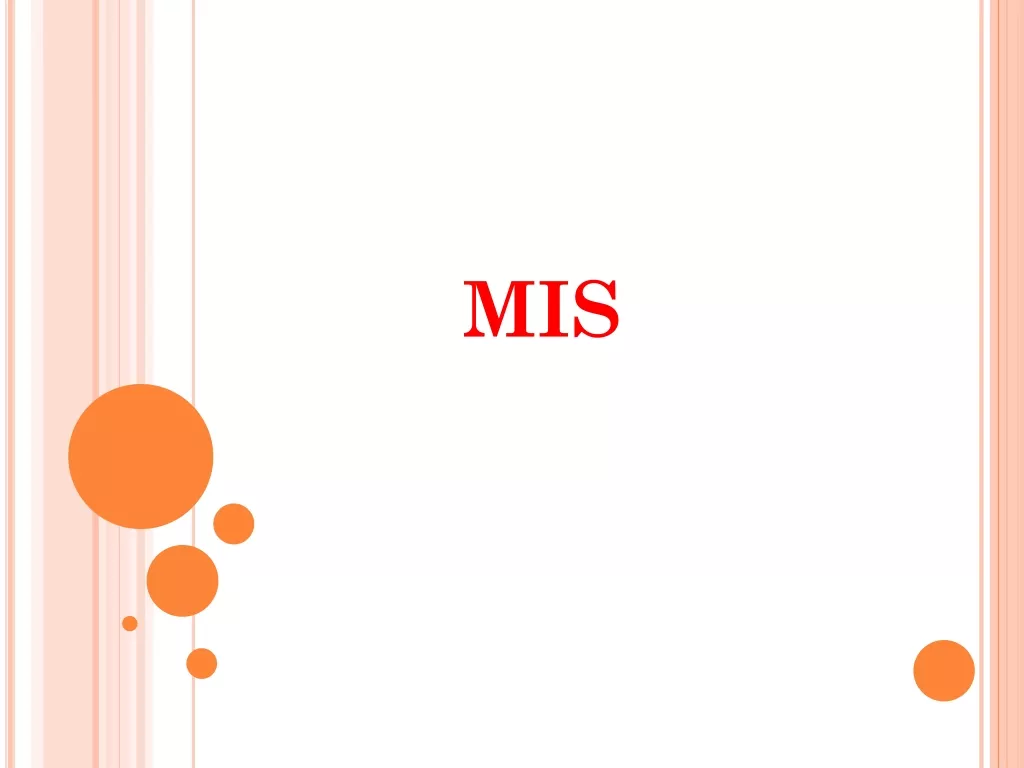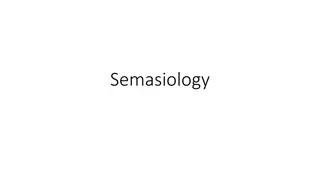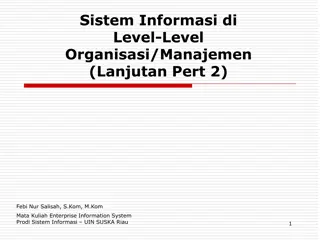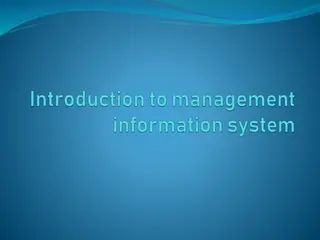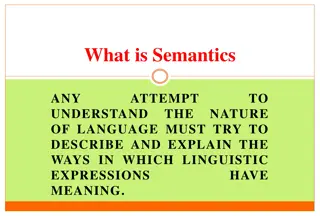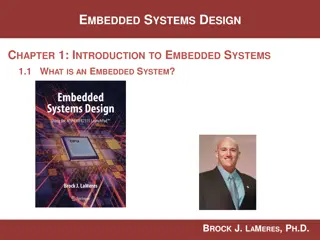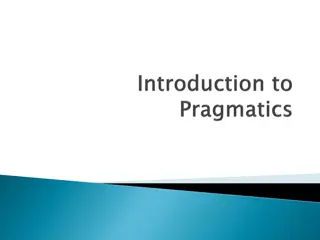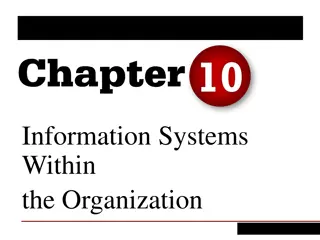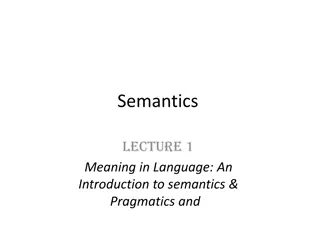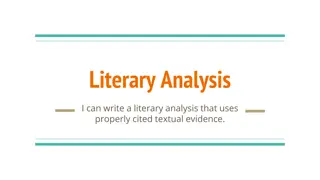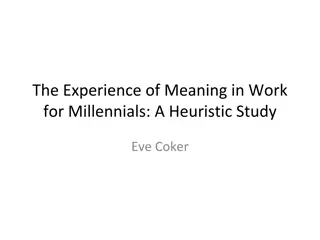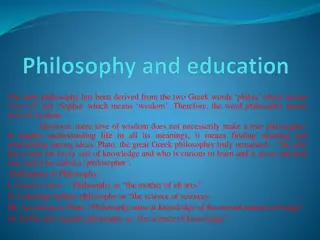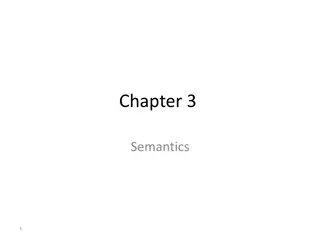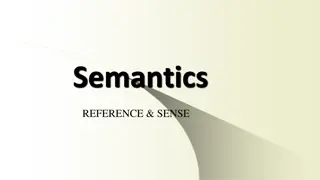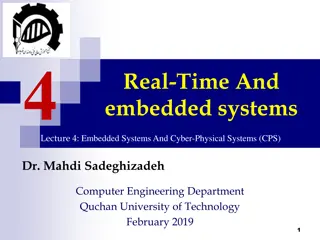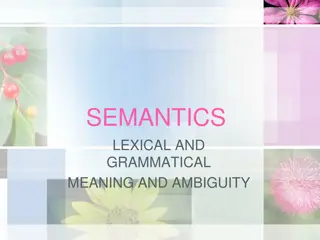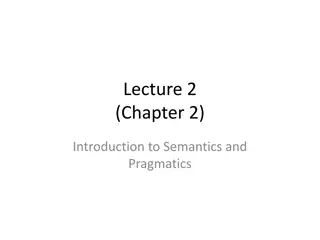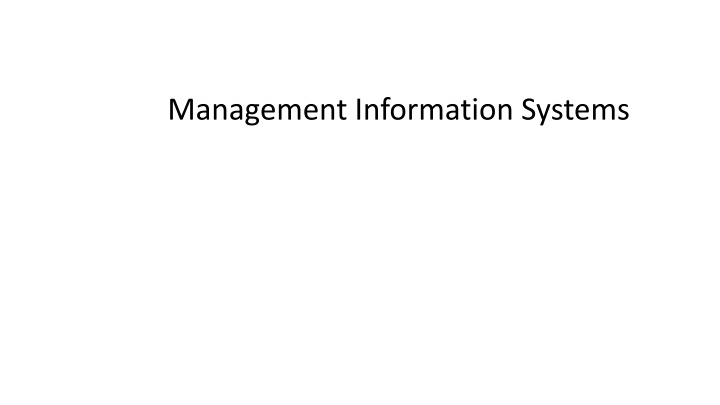
Meaning of Management Information Systems
Management Information Systems (MIS) involve understanding management, information, and systems for effective organizational planning, control, and administration. MIS processes data to support management functions by transforming raw facts into organized information, facilitating decision-making and control within an organization. Pillars of MIS include long-term planning, respect for organizational dynamics, comprehensive interconnectivity, and the use of IT for all management levels.
Download Presentation

Please find below an Image/Link to download the presentation.
The content on the website is provided AS IS for your information and personal use only. It may not be sold, licensed, or shared on other websites without obtaining consent from the author. If you encounter any issues during the download, it is possible that the publisher has removed the file from their server.
You are allowed to download the files provided on this website for personal or commercial use, subject to the condition that they are used lawfully. All files are the property of their respective owners.
The content on the website is provided AS IS for your information and personal use only. It may not be sold, licensed, or shared on other websites without obtaining consent from the author.
E N D
Presentation Transcript
1. MEANING OF MIS 1.1. Understanding the keywords Management, Information, and Systems What is Management? Planning, control, and administration of an organization. Management is generally hierarchical: Top managers handle planning; Mid career managers control; And, junior managers administer. What is Information? Processed data to support management functions Processing record, summarize, store, and retrieve. Present in the required reporting format.
1. Meaning of MIS .. 1 What is a System? (in the context of MIS) An inputs processing - output and feedback matrix. Supports the processing of data into information. 1.2. Objectives of MIS MIS processes data to support the management functions. MIS manages information system (IS) productively: Competitive advantage created from using information maximally: Capturing Data collects the relevant data. Processing Data transforms data into information. Information Storage store the information securely. Information Retrieval easy retrieval by authorized users. Information Propagation nonstop access and updating.
1. Meaning of MIS ..2 1.3. Pillars of MIS Long-term planning perspective. Respect of an organization s dynamics and structure. Comprehensiveness and interconnectivity. Hierarchical and wholly participatory Supports all levels of management decisions: strategic, operational and tactical. Highlights problems and exceptional situations. Driven by Information technology (IT). Computer-based - Hardware, software, and telecom.
1. Meaning of MIS ..3 1.4. Information Vs Data Raw facts representing events. Organized and arranged in standard formats. Arranged to ease understanding and use. Rendered to support decision making.
1. Meaning of MIS . ..4 1.5. The Knowledge Organization Organizational structures changing rapidly. From hierarchical to flattened structures. From centralized to decentralized management. From rigid to flexible arrangements. Intra and inter firm businesses easier. Location and size no longer matters. Costumer preferences is venerated. Organizations and the managers continue learning. Competencies increasingly important. Flow of information to all stakeholders is important.
1. Meaning of MIS .. 5 1.5. The Knowledge Organization Intangible assets become key measures of wealth: Securities, proprietary knowledge, brand, etc.; Intellectual capital, innovation, unique business model; Credit cards, goodwill, cultural advantages Travels and tours, package delivery, etc., are valuable. Sound IT competencies a key success factor. Qualitative information vital for success. 1.6. What Is an Information System (IS)? A unified data and knowledge (soft) infrastructure. Collect/retrieve, process, store, and dispense information. Supports decision making and control.
1. Meaning of MIS ..6 1.6.1. Uses of IS in the Organization Facilitates analysis of problems; Provides deep insight into complex subjects; Supports creation of new products. 1.6.2. Components of IS input, processing, and output, and a feedback system Input - captures or collects raw data Processing - converts raw input into a meaningful form. Output - transfers the processed information the users. The feedback is output returned by the users. Feedbacks supports evaluation at the input stage.
Meaning of MIS 7 1.6.2. Components of IS An IS focuses on the organization and its environment. IS captures all the stakeholders - customers, suppliers, etc. Regulatory agencies also interact in the IS of firms. Technically, IS are IT-based information systems. 1.6.2.1. Computers vs IS Computers store and process information. Computers are only part of an IS. Computer programs, or software, support processing. Software are sets of operating instructions. Knowing how computer programs work is vital.
1. Meaning of MIS ..8 1.6.3. Business information value chain For a firm, IS supports the business information value chain. IS adds value by providing problem-solving knowledge. The key domains of IS: Organizational; Management; Technological. But IS has to fit into the organization s culture. IS cannot replace creativity of the manager.
2. GENERAL PRINCIPLES OF MIS 2.1. What is MIS? MIS supports Management with information for: Operations Administration Decision making The foundation of MIS is databases. Today s MIS is a computerized processing system. MIS differ from other ISs because: MIS is used to analyze information MIS also facilitates strategic and operational activities.
2. General Principles of MIS .. 1 2.1.1. Primary Components of MIS? The five primary components of MIS are: 1. Hardware 2. Software 3. Data (information for decision making), 4. Procedures (design, development and documentation), 5. People (individuals, groups, or organizations). Raw facts representing events. Data is organized in standard formats or databases Databases ease understanding and use. MIS is founded on databases.
2. General Principles of MIS 2 2.2. Evolution of MIS At first, MIS treated data and reported at regular intervals. Later, data was distinguished from information; o data being a raw material and, o information the finished product. MIS had to present information in formats that: o create impact on its user; o And, provokes a decision or an investigation. The concept of exception reporting makes MIS more impactful Data is rendered accessible to authorized parties. But processed further to suit the needs of different users. Data is one, but viewed in different ways.
2. General Principles of MIS 3 2.2.1. The Concept of End-User Computing End users work with multiple databases. This decentralized the MIS. End users became independent of computer professionals. Then the MIS became a decision making system. 2.2.2. The Modern Concept of MIS Handles the databases, Provides computing facilities to the end user, gives decision making tools to the users, And connects firms to organizations. MIS is concerned with how to use information.
2. General Principles of MIS .. 4 2.2.2. The Modern Concept of MIS Information is generated through data analysis. Data analyses relies on many academic disciplines. Management, Psychology, Human Behavior, Engineering etc. Thus making MIS more effective and useful. MIS is founded on the systems theory. Offers solutions input - output flow challenges. Using theories of communication. An input Process Output systems without noise. Ensures flow of information from a source to a destination. A blend of Management, Information and IT System.
2. General Principles of MIS .. 5 2.3. History of MIS MIS growth agrees with growth of computing technology: 1. Mainframe and minicomputer computing; 2. Personal computers; 3. Client/server networks; 4. Enterprise computing; 5. And, Cloud computing. Phase 1 - Mainframe and minicomputer computing Ruled by IBM and their mainframe computers. Mainframe computers were quite large. Required teams to run them.
2. General Principles of MIS .. 6 2.3. History of MIS Phase 2: Personal Computers Personal computers (PCs) became popular in 1965. Microprocessors replaced mainframes and minicomputers. This accelerated the decentralizing computing power. Large data centers were replaced with smaller offices. By late 1970s PCs make computing cheaper. Low cost computers became mass market commodities. More individuals were computing with PCs.
2. General Principles of MIS .. 7 2.3. History of MIS Phase 3: Client/Server Computers were linked to servers. Servers share information via a common network access. Data sets became accessible to many simultaneously. Phase 4: Enterprise Computing High speed networks became popular. Firms could integrate all aspects of the activities. MIS linking all aspects of a firm s activities was created. Using computers became an important skill for all persons.
2. General Principles of MIS .. 8 2.3. History of MIS Phase 5: Cloud Computing This (the latest) employs networking technology extensively. Applications and data storage are delivered to users. This is independent of configuration, location or hardware. High speed cell phone and Wi-Fi networks are also delivered. Managers use the MIS remotely via any networked device. This has increased the possibility of having multiple jobs.
2. General Principles of MIS .. 9 2.4. Physical view of MIS MIS has sub-systems for: Data collection; Transaction processing and validating; Processing; Analyzes and storing of information in databases. The subsystem can be at the micro or macro-levels. MIS is dynamic and subject to change. Changes occur from internal management process. Changes emanate also from the external environment.
3. THE ROLE OF MIS IN AN ORGANIZATION MIS in an organization is akin to the heart in the body. The information is the blood and MIS is the heart. Support to sub-systems MIS works through a variety of systems, such as; Query Systems, Analysis Systems, Modeling Systems, And, Decision Support Systems. Support for Long term (Strategic) Planning MIS helps long term planning in several ways, including; Strategic Planning and Management Control, Operational Control and Transaction Processing.
3. The Role of MIS in an Organization .. 1 Support for Transaction Processing Answers queries on the data relating to transactions; the status of a particular record, and, references on a variety of documents. Helps the junior management personnel by; providing the operational data for planning, scheduling and control, supports decision making at the operations level, and, corrects an out of control situation.
3. The Role of MIS in an Organization .. 2 Support for Short Term Planning Helps the mid career managers in the following; short them planning, target setting and and, controlling the business functions. Helps the top managers in the following; goal setting, strategic planning and evolving the business plans and, the business plan implementation. Supports information generation and communication. Aids problem identification and sound decision making.
3. The Role of MIS in an Organization .. 3 3.1. MIS in Public Sector Organizations (PSOs) PSOs are increasingly inundated with data and information. PSOs need IS to support its various activities. 3.1.1. Centralized Vs. Decentralized PISs PISs need to cover eight main areas of responsibility: information systems planning; organizational structures and staffing; data management; computing and data management architecture; information systems development; information technology acquisition; training, and technical support.
3. The Role of MIS in an Organization .. 4 3.1.1. Centralized Vs. Decentralized PISs A centralized PIS may be efficiency, but difficult to manage. A decentralized PIS spreads the tasks, but may be wasteful. A mix of central and local action is considered most effective. 3.1.2. MIS and Public Sector Accountability The broad set of accountabilities in PSOs include: Managerial accountability; Political accountability; And, Financial accountability
4. CONTENT, DESIGN AND PERFORMANCE OF MIS 4.1. Types of Information There are four main types of information, namely; Descriptive information, diagnostic information, predictive information, and prescriptive information. 4.1.1. Descriptive information It tries to answer the question, what is happening? It covers such information as: Financial results and maintenance records; And, Production records, product marketing, and test results.
4. Content, Design and Performance of MIS .. 1 4.1.1. Descriptive information Can help to secure other needed types of information. Not enough for identifying and solving management problems. 4.1.2. Diagnostic information Seeks to answer the question - what is wrong? Can be used to define problems that develop in the business. Can find an how to solve the problem (including doing nothing). What is and what ought to be should be viewed together. 4.1.3. Predictive information Seeks to answer the question - what would happen if.. Generated from an analysis of possible future events.
4. Content, Design and Performance of MIS .. 2 4.1.3. Predictive information Is exceedingly valuable with desirable outcomes. Manager use predictive information to reduce risk and uncertainty. Predictive models include; budgeting techniques, simulation models, and other tools that measure expected changes in the business. 4.1.4. Prescriptive information Seeks to answer the question- What should be done? Not adequate for decision making. Used with the goals and values of the manger for decision making.
4. Content, Design and Performance of MIS .. 3 4.1.5. Classes of Information Organizational information Information required sub-units of an organization. The same information may serve different uses. Often stored in database for the users. Functional information Used by the functional heads for administrative functioning. Often function-specific, each unit can have its own. Largely factual, statically focusing on specific task details. Assessable by unit objectives, work design and responsibility.
4. Content, Design and Performance of MIS .. 4 4.1.5. Classes of Information Knowledge information Compels the manager to think, decide and act. Highlights the deviation norms and abnormal variations. Supports the function of middle and top management. Often presented graphically for quick grasp, E.g.: Students population may be declining; Or, market demand is falling. Decision-support information Justifies a change or amendment of the existing decisions. E.g., inspection report, demand forecast, etc. Can be sourced internally and externally
4. Content, Design and Performance of MIS .. 5 4.1.5. Classes of Information Operational information Required by operators and Junior managers. Helps decisions that affect operations. Determined internally, through the transaction processing. Largely of short time span and focuses on the current status. 4.1.6. Determining Information Requirement Asking & interviewing using mainly closed ended questions. Using expert testimonies Experiences from past decisions and problem solving.
4. Content, Design and Performance of MIS .. 6 4.2. Data Modeling The data model determines what data in the database. It explores the relation between data entities. It represents the required data accurately. 4.2.1. Databases Databases are now necessary in nearly all fields. Collection of structured, interrelated data sets rendered accessible. A set of application programs to update and manage the system. Three key requirements of good databases: Reliability broad analysis in robustness, concurrency and security. Efficiency high speed and pliability to new requirements. Renewability ease of adaptability to software progression.
4. Content, Design and Performance of MIS .. 7 4.3. Designing MIS Consider a typical University in Buea or elsewhere. Huge volumes of data have to be collected, analyzed and used. Personal record of staff and students; Courses registration by programs and by students. Examination records - students grades by CA and exams. Financial records accounts, payroll, and students fee records, etc. E.g. it should be possible to do the following: Assign courses by student, program, and level. Determine students class eligibility by fee, pre-requisite courses. Determine class attendance by lecturers/students.
4. Content, Design and Performance of MIS .. 8 4.3. Designing MIS Prepare results/transcripts by semester and end of program. Produce payroll records and monthly pay slips. Prepare periodic statement of accounts Produce tax and social insurance records Other records as are needed internally and externally. These require complex data sets and fixing many reports. 4.3.1. Database Schemes Three database schemes - Physical, Conceptual, and view levels. Physical level having to do with the storage and retrieval. This is the back end that is hidden from users.
4. Content, Design and Performance of MIS .. 9 4.3.1. Database Schemes Conceptual level Having to do with the content and how the system is networked. This is handled by the database administrator View level Viewed by the different sets of users simultaneously Viewed in different ways and for different purposes. 4.3.2. Data Models Conceptual tools to describe data relations, data constraints and data semantics. There are object-based, record-based and physical data models.
4. Content, Design and Performance of MIS .. 10 4.3.2. Data Models Object-based models: Related to the conceptual and view levels, provides flexible structuring capabilities, and specifies data constraints explicitly. Record-based models: Focuses on the conceptual and view levels. Used mainly for databases with fixed record structure. With fixed sizes of the fields of the records. Physical data models: focuses on the physical level. Data model should remain fixed when the physical level changes.
4. Content, Design and Performance of MIS .. 11 4.3.3. Standard terminology in Database Management Data Definition Language (DDL) Used to describe the structure, relations, constraints of databases. The compiled DDL statements are called the data directory. Data Manipulation Language (DML) Used to select and modify (insert, update, delete) the database. In nonprocedural DMLs the user only specifies what data is needed, In procedural DMLs the way it should be retrieved is pedetermined. Database Manager This application connects the users to the database. The application enforces most requirements of the database.
4. Content, Design and Performance of MIS .. 12 4.3.3. Standard terminology in Database Management Database Administrator The expert directing the Database. Defines database schemes and the storage structure. Specifies the access methods, entry rules and integrity constraints Database Users Expert users - interact with the system via DML calls. Naive users - interact with the system via application programs. File manager -responsible for storage low size data and retrieval. Database manager- See above. Query processor - Translates a query language into low-level instructions. DDL compiler - Converts DDL statements into database metadata.
4. Content, Design and Performance of MIS .. 13 4.3.3. Standard terminology in Database Management Query processor - Translates a query language into low-level instructions. DDL compiler - Converts DDL statements into database metadata. Data file - Store the data themselves. Data directory - Stores information about the structure of the database. Indices - Accelerate data retrieval from the database. 4.3.4. Data Collection Techniques Surveys field data collected via a questionnaire. Desk review data collected from records. Objective measures or tests data collected during an experiment. Interviews - data collected using a series of pre-conceived questions.
4. Content, Design and Performance of MIS .. 14 4.4. Challenges of Dealing Databases Data redundancy and inconsistency: An information should not be generated at different points. The data set be updated consistently. Data integrity: Data stored should fulfills certain prescribed constraints. The system should adapt readily to change of the constraints. The system should recover from crashes with little difficulty. Data access: The system should generate answers to queries; Supports efficient data retrieval by indexing, hashing, etc.
4. Content, Design and Performance of MIS .. 15 4.4. Challenges of Dealing Databases Data isolation: Receives different types and magnitudes of data; like text documents, numerical data, photos, etc. Concurrency: supports simultaneous use without deadlocks. Consistency of the data despite multiple use. Security: Has access rights for users and safety of database.
5. BUSINESS PROCESS INTEGRATION 5.1. Enterprise Systems (ES) ES are packaged enterprise application software (PEAS) systems. ESs have process orientation including: Enterprise resource planning (ERP); Customer Relationship Management (CRM), Supply Chain Management (SCM). The distinction between ES and IS: ES refers to software, whereas an IS a social system that uses IT. An IS includes people and IT. 5.2. Supply chain management (SCM) The management of a network of interconnected businesses. Network involved in the provision of products and services.
5. Business Process Integration ..1 5.2. Supply chain management (SCM) The end-points of SCM are the end-customers. SCM spans all movement and storage of the following: Raw materials, work-in-process inventory, and finished goods The supply chain is from the origin to point of consumption. More firms now need supply chains to connect global markets. 5.2.1. Traditional SCM Traditionally, firms focuses on the inputs and outputs processes. With little concern for how other individual players worked. But linkages within the supply chain network is growing.
5. Business Process Integration ..2 5.3. Developments in SCM Six major eras are observable in the evolution of SCM studies: Creation, Integration, and Globalization; And, specialization Phases One and Two, and SCM 2.0. a. Creation Era SCM was used by a US industry consultant in the early 1980s. But the notion of a supply chain existed since the early 20th century. The early focus was in manufacturing assembly line. b. Integration Era The development of Electronic Data Interchange (EDI) systems. The introduction of Enterprise Resource Planning (ERP) systems. increasing value-adding and cost reductions through integration.
5. Business Process Integration 3 5.3. Developments in SCM c. Globalization Era Although the use of global sources in SCM is traceable to the 1940s. However, by late 1980s more firms were integrate globally. The goal is to increase competitive advantage, through: Value addition; And, reducing costs through global sourcing. d. Specialization Era d.1. Phase One: Outsourced Manufacturing and Distribution Companies abandoned vertical integration, Many firms close non-core operations, Outsourcing is preferred to having diverse support units.
5. Business Process Integration 4 5.3. Developments in SCM d. Specialization Era d.2. Phase Two: SCM as a Service Specialization within the supply chain led to the growth of: Transportation brokerages, Warehouse management, And, non-asset-based carriers SCM goes beyond transportation and logistics. SCM increasingly involves the following: supply planning, collaboration, execution and performance management.
5. Business Process Integration 5 5.3. Developments in SCM d. Specialization Era d.2. Phase Two: SCM as a Service Specialization improves overall competencies; Just as outsourced manufacturing and distribution has done. Firms are able to use supply chain expertise without developing them. This reduced cost significantly And, has made supply chain specialization very popular. e. Supply Chain Management 2.0 (SCM 2.0) Web 2.0 is characterized by the use of the World Wide Web. This has led to more creativity, information sharing, and partnerships.
5. Business Process Integration .6 5.3. Developments in SCM e. Supply Chain Management 2.0 (SCM 2.0) Organizations have delivery options that produces speedy results. The speed of supply chain increases due to global competition. Short product life cycles and expanded specialization. 5.4. Supply Chain Business Process Integration Change from managing individual functions to supply chain processes. Collaborative work between buyers and suppliers, Joint product development, Common systems and shared information. Integrated supply chain requires a continuous information flow. Dominance of a process approach to the business.
5. Business Process Integration 7 5.4. Supply Chain Business Process Integration Change from managing individual functions to supply chain processes. Collaborative work between buyers and suppliers, Joint product development, Common systems and shared information. Integrated supply chain requires a continuous information flow. Dominance of a process approach to the business. 5.5. Aspects of SCM Customer relationship management Demand management Returns management Manufacturing flow management Supplier relationship management Customer service management Order fulfillment Product development and commercialization
5. Business Process Integration 8 5.5. 1. Customer Relationship Management (CRM) The link between the organization and its customers. Building customer relationships: Set equally satisfying goals for organization and customers; Establish and maintain customer rapport; Produce positive feelings for organization and the customers CRM uses technology to manage business processes. Especially in sales, marketing, customer service, and technical support. Aims to find and retain clients. Reduce the costs of marketing and client service. Effective CRM promotes synergy and profitability, and reduces costs.

